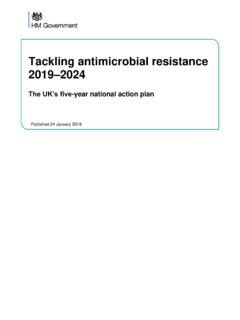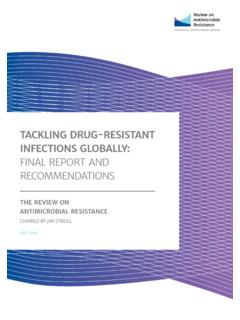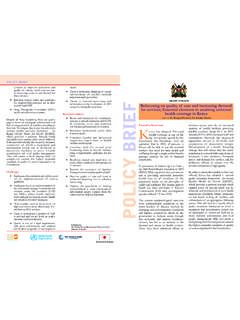Transcription of CDC in Haiti
1 CDC in Haiti The Centers for Disease Control and Prevention (CDC) established an office in Haiti in 2002 with an initial focus on HIV/AIDS. After a devastating magnitude earthquake in January 2010, CDC's support expanded to address Haiti 's critical health needs, such as cholera, as well as longer-term public health interventions. CDC's increased support to the Ministry of Public Health and Population has resulted in substantial advances in health security and public health system strengthening in Haiti . CDC STAFF. 10 Assignees 54 Locally Employed Haiti AT A GLANCE.
2 HIV. Population: 10,981,229 (2017). HIV is a leading cause of death and a health threat to millions worldwide. Per capita income: $1,830 As a key implementer of the President's Emergency Plan for AIDS Relief Life expectancy at birth: F 67/M 62 years (PEPFAR), CDC works with Haiti 's Ministry of Public Health and Population Infant mortality rate: 59/1,000 live births (MSPP) to build a sustainable, high-impact national HIV response program with the goal to achieve epidemic control of HIV. CDC supports national efforts Sources: World Bank 2018, Haiti to prevent the transmission of HIV; increase the accessibility and quality of Population Reference Bureau 2018, Haiti HIV clinical services and treatment; increase patient adherence and retention in treatment; strengthen surveillance, epidemiology, laboratory, and health information management systems; and expand the overall availability of TOP 10 CAUSES OF DEATH tuberculosis (TB) treatment screening and treatment.
3 1. lschemic heart disease Global Health Security 2. Stroke In today's globally connected world, disease threats can spread faster and more 3. Lower respiratory infections unpredictably than ever before. CDC's global health security efforts in Haiti 4. Neonatal disorders help improve the country's ability to prevent, detect, and respond to infectious disease outbreaks before they become global epidemics. These efforts are 5. Road injuries helping Haiti reach the targets outlined in the Global Health Security Agenda, 6. Diabetes a global partnership launched in 2014 to help make the world safer and more 7.
4 HIV/AIDS secure from infectious disease threats. 8. Diarrheal diseases CDC is supporting the government of Haiti to minimize disease threats by 9. Congenital defects bolstering laboratory and disease surveillance capacity, improving emergency 10. Interpersonal violence preparedness and response, facilitating immunization efforts, and addressing Source: GBD Compare 2018, Haiti antimicrobial resistance . CDC supported the establishment of a laboratory- enhanced surveillance system and Haiti 's National Epidemiological Surveillance Network, which monitors disease trends and detects potential outbreaks in real time, permitting timely case investigations.
5 Additionally, CDC increased laboratory testing capacity in Haiti by supporting the establishment of a National Specimen Referral Network for the efficient transport of specimens to the National Public Health Laboratory. Field Epidemiology Training Program CDC supports Haiti in strengthening the capacity of its workforce to investigate and respond to disease outbreaks through the establishment of a Field Epidemiology Training Program (FETP). FETPs train a workforce of field epidemiologists or disease detectives to identify and contain outbreaks before they become epidemics.
6 Participants focus on learning by doing to develop the skills for gathering critical data and turning it into evidence-based action. FETP residents and graduates are a vital component of Haiti 's health workforce and promote health security throughout all levels of Haiti 's public health system. Graduates serve in leadership roles as departmental health directors, work in the field collecting and analyzing surveillance data, and provide crucial epidemiological expertise during emergencies. Over 350 fellows IMPACT IN Haiti . have graduated from the program since it was established in 2011.
7 98% of all pregnant women seen at Cholera a health facility were tested for HIV. The Haitian government confirmed an outbreak of cholera in October 2010. As of 2018, nearly 820,000 suspected cases and more than 9,000 deaths have been reported. CDC is a major partner in Haiti 's Long-term Cholera Elimination The National Surveillance Network Plan and is supporting efforts to eliminate cholera transmission by improving diarrheal disease surveillance, enhancing laboratories capacity to culture expanded from 51 sites in 2010 to 652.
8 Specimens, training rural potable water and sanitation technicians, expanding sites in 2018, covering more than 60%. water, sanitation, and hygiene (WASH) capacity, and supporting oral cholera of the health facilities in Haiti . vaccine campaigns. Although cholera remains a persistent public health threat, cases are down 99% from the peak of the epidemic in 2011. TB and Multi-drug Resistant TB 100% of TB patients received an HIV. Haiti has the highest incidence of TB in the Western Hemisphere. To increase test, and 100% of TB-HIV patients TB case detection, CDC has worked closely with the MSPP to build TB-related received ART in 2018.
9 Laboratory and clinical capacity at high-volume sites throughout Haiti . Laboratory diagnostic capacity for TB has expanded considerably, contributing to an overall increase in TB case finding since 2010. CDC is also supporting the MSPP to improve multi-drug resistant TB (MDR-TB) case detection and treatment TB treatment success rate (~82%) is through the establishment of a national biosafety level 3 (BSL-3) laboratory. among the highest in Latin America Approximately of all new TB cases and 13% of previously treated cases in and the Caribbean.
10 Haiti test positive for MDR-TB. The national BSL-3 laboratory will greatly augment Haiti 's capacity to detect and treat MDR-TB and support critical research into the evolution of TB drug resistance in Haiti . Approximately 5 million individuals are Malaria no longer at risk of lymphatic filariasis Malaria is a leading cause of death and disease in many developing countries. due to successful implementation of Malaria Zero was established to eliminate malaria from Hispaniola the island that includes Haiti and the Dominican Republic creating a malaria-free zone mass drug administration in 101 of across the Caribbean.

















